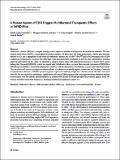Por favor, use este identificador para citar o enlazar a este item:
http://hdl.handle.net/10261/283149COMPARTIR / EXPORTAR:
 SHARE SHARE
 CORE
BASE CORE
BASE
|
|
| Visualizar otros formatos: MARC | Dublin Core | RDF | ORE | MODS | METS | DIDL | DATACITE | |

| Título: | A Mutant Variant of E2F4 Triggers Multifactorial Therapeutic Effects in 5xFAD Mice |
Autor: | López-Sánchez, N.; Ramón-Landreau, Morgan CSIC ORCID; Trujillo, Cristina CSIC ORCID; Garrido-García, A. CSIC ORCID; Frade López, José María CSIC ORCID | Palabras clave: | Alzheimer’s disease Aβ deposits E2F4 phosphorylation Neuronal tetraploidy RNA-seq Y-maze. |
Fecha de publicación: | 2022 | Editor: | Springer Nature | Citación: | Molecular neurobiology 59: 3016- 3039 (2022) | Resumen: | Alzheimer’s disease (AD) has a complex etiology, which requires a multifactorial approach for an efficient treatment. We have focused on E2 factor 4 (E2F4), a transcription factor that regulates cell quiescence and tissue homeostasis, controls gene networks affected in AD, and is upregulated in the brains of Alzheimer’s patients and of APP/PS1 and 5xFAD transgenic mice. E2F4 contains an evolutionarily conserved Thr-motif that, when phosphorylated, modulates its activity, thus constituting a potential target for intervention. In this study, we generated a knock-in mouse strain with neuronal expression of a mouse E2F4 variant lacking this Thr-motif (E2F4DN), which was mated with 5xFAD mice. Here, we show that neuronal expression of E2F4DN in 5xFAD mice potentiates a transcriptional program consistent with the attenuation of the immune response and brain homeostasis. This correlates with reduced microgliosis and astrogliosis, modulation of amyloid-β peptide proteostasis, and blocking of neuronal tetraploidization. Moreover, E2F4DN prevents cognitive impairment and body weight loss, a known somatic alteration associated with AD. We also show that our finding is significant for AD, since E2F4 is expressed in cortical neurons from Alzheimer patients in association with Thr-specific phosphorylation, as evidenced by an anti-E2F4/anti-phosphoThr proximity ligation assay. We propose E2F4DN-based gene therapy as a promising multifactorial approach against AD. | Versión del editor: | http://dx.doi.org/10.1007/s12035-022-02764-z | URI: | http://hdl.handle.net/10261/283149 | DOI: | 10.1007/s12035-022-02764-z | Identificadores: | doi: 10.1007/s12035-022-02764-z issn: 1559-1182 |
| Aparece en las colecciones: | (IC) Artículos |
Ficheros en este ítem:
| Fichero | Descripción | Tamaño | Formato | |
|---|---|---|---|---|
| 12035_2022_Article_2764.pdf | 12,72 MB | Adobe PDF |  Visualizar/Abrir |
CORE Recommender
SCOPUSTM
Citations
2
checked on 06-abr-2024
WEB OF SCIENCETM
Citations
2
checked on 25-feb-2024
Page view(s)
23
checked on 16-abr-2024
Download(s)
24
checked on 16-abr-2024
Google ScholarTM
Check
Altmetric
Altmetric
Este item está licenciado bajo una Licencia Creative Commons

